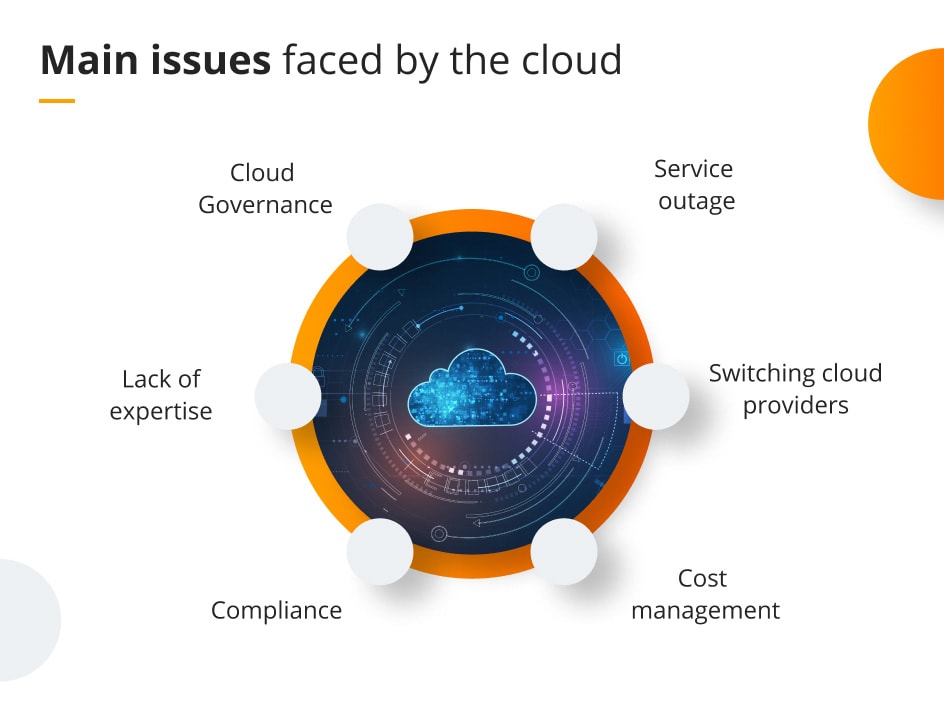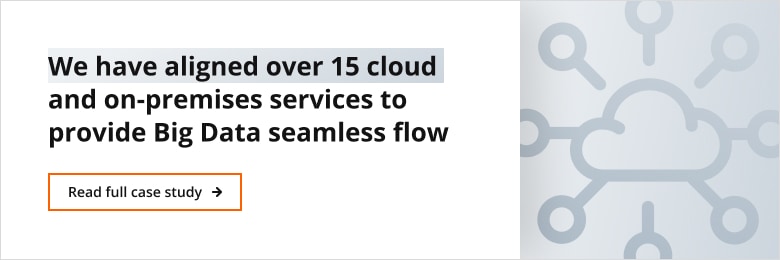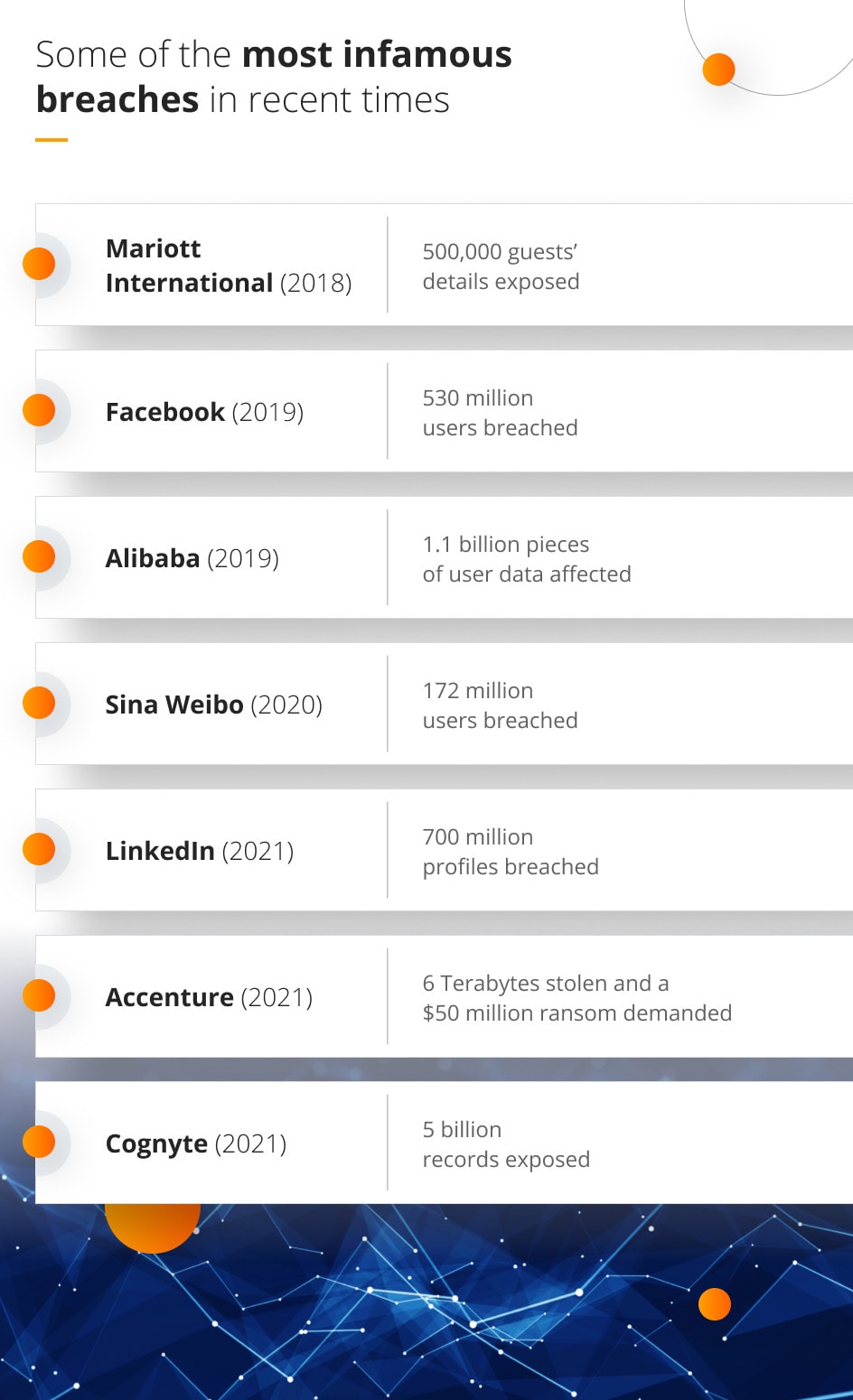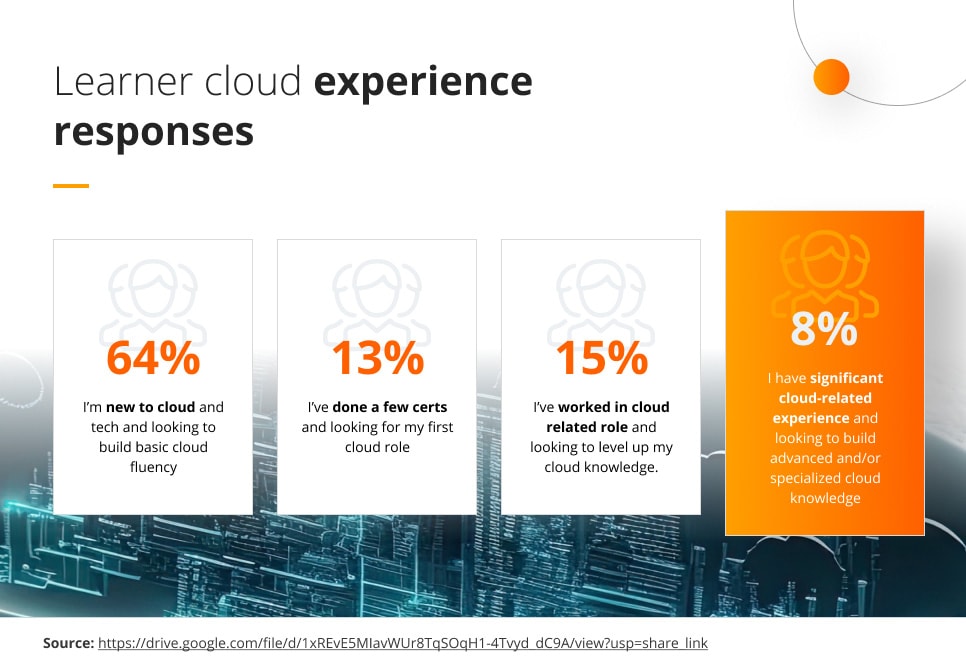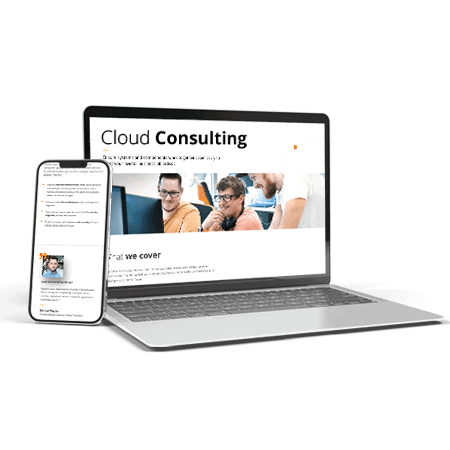
The most common problems in cloud implementation
As we transition into an ever-growing digital world, many companies are adopting cloud computing as a means to modernise their operations.
More than 85% of organisations will embrace a cloud-first strategy by 2025, and 95% of new digital workloads will be deployed on cloud-native platforms (up from 30% in 2021).Gartnerhttps://www.gartner.com/en/newsroom/press-releases/2021-11-10-gartner-says-cloud-will-be-the-centerpiece-of-new-digital-experiences
As we transition into an ever-growing digital world, many companies are adopting cloud computing as a means to modernise their operations.
Cloud computing offers many benefits, as it delivers services such as access to external servers and databases, greater storage, data software and analytics, improved economies of scale and flexible resources.
By 2025, 95% of new digital workloads will be deployed on cloud-native platforms, up from 30% in 2021.Gartnerhttps://www.gartner.com/en/newsroom/press-releases/2021-11-10-gartner-says-cloud-will-be-the-centerpiece-of-new-digital-experiences
When choosing a cloud provider, companies are faced with numerous options. As well as looking at the services each provider has to offer, discerning businesses must also consider factors such as the cost of their cloud migration, the disadvantages of cloud computing and how these might affect their operations, and the cloud challenges that they may face.
It is clear that adopting a cloud-based strategy and embracing cloud computing is no longer a concept ‘for the future’ – it is the present. But before committing to migrating its business to the cloud, it is important for companies to fully understand the challenges and common problems they may face in order to be well-prepared for what’s to come.
What are the main issues faced by the cloud?
Cloud Governance
When operating with a public or hybrid cloud, the CSP (Cloud Service Provider) offers resources in two ways: either directly to the customer, or in a limited form, ‘as a service”.
In both of these operations, the customers have full control over cybersecurity, networking and resource allocation, but they do not have any control over the physical configuration or physical inspection of the hardware. This is because the cloud service provider manages all of the Cloud Governance aspects: security, networking and resources on the physical layer.
Obviously, if a company chooses to use a private cloud environment, they will mitigate this challenge and have full control of their private cloud. Implementing cloud environments without the use of public cloud resources will ensure that the full oversight remains with the company by creating a private cloud.
Service outage
Any downtime with a public CSP is entirely out of the company’s control. This can create issues for businesses with critical live processes, as they cannot operate when interruptions occur. In an effort to mitigate this type of scenario, the customer configures the expected availability and resilience configuration, which helps them to manage any possible negative consequences to a datacentre or a region when they experience a service outage .
Switching cloud providers
Once your operations are set up with a particular provider, it can be extremely difficult to switch, locking you in with that provider almost indefinitely. This is known as a ‘cloud / vendor lock’.
Cost management
Setting up a private cloud requires a significant initial investment. While public clouds demand far less capital investment from the outset, as the business scales, these costs can skyrocket, depending on the number of services and data you use.
Lack of expertise
Pluralsight’s State of Cloud Report 2022 notes that ‘75% of leaders are building new products and features in the cloud, but only 8% of technologists have extensive experience working with cloud-related tools’ – this lack of expertise can lead to tools either being underutilised or used incorrectly.
Compliance
Organisations must comply with the local legislation as set out by their local government bodies. If the cloud service provider falls under conflicting compliance rules, this can create issues for the company.
What are the security challenges in cloud computing?
Security is one of the biggest challenges in cloud computing and one that companies find they struggle with the most when migrating their operations to the cloud.
Cloud service providers use state-of-the-art technologies, standards and best practices, but despite their best efforts, it is simply impossible to be 100% protected against possible attacks. Although even ‘public’ cloud services are not in fact public to absolutely everyone (they can be limited to chosen IPs, users, groups, and so on), they are still public, meaning they will always be vulnerable to attacks and data breaches.
As discovered in Pluralsight’s 2022 State of Cloud Report which surveyed 1000 tech leaders regarding their thoughts and experience on the current state of the cloud, while security is widely known to be an area of the utmost importance when it comes to cloud computing, there is also a large skills gap that keeps industry leaders concerned.
40% of learners and leaders indicate security is the top skills gap AND the top challenge in preventing organisations from achieving cloud maturity.PluralsightState of Cloud Report 2022
Pluralsight goes on to note that moving to a cloud-based strategy of operations without the required knowledge and skills base can create vulnerabilities and risk factors that are a great threat to security.
Cloud security attacks do happen, unfortunately. Here are some of the most infamous breaches in recent times:
While CSPs put processes in place to reduce the risk of an attack successfully breaching companies’ or users’ data (such as multiple-level password authentication, firewalls and implementing AI intelligence), unfortunately, it is impossible to protect against 100% of attacks.
Why does cloud implementation fail?
Implementing cloud computing can be very difficult, and while many companies succeed in cloud adoption, some companies do struggle with their cloud challenges. There are a number of reasons why businesses might not be successful in their cloud services implementation, as explained below.
The cost of migrating to the cloud
Migrating to the cloud can be a very expensive operation if it is not optimally managed. There are a huge number of costs involved, from technology and vendor lock-in, failed migrations, sticker shock, controlling access and so on.
Sometimes, these costs can spiral out of control, which may result in the cloud migration failing or being significantly delayed. This can be a huge problem for companies when rolling out their cloud migration strategy and it could entirely derail their operations.
These costs have been dubbed ‘The Cloud Migration Bubble’.
There are three main stages as shown above: planning, migrating, and operation and optimisation. It is in the migration stage that costs can really soar, causing companies huge problems with managing their costs and keeping the migration viable.
Companies can work closely alongside the cloud service provider to reduce the costs involved and improve their efficiency. This is done through a careful planning stage that seeks to map out the potential costs they may face in their migration and working with the CSP to try to reduce them.
Without a strong planning stage, it’s very hard to effectively stay on top of the potential costs of migrating to the cloud, which is a major reason that many companies fail in their cloud migration journey.
Lack of understanding or expertise in cloud technology
As mentioned previously in this article, a lack of expertise in cloud-technology can be a big roadblock for companies who seek to implement their cloud-based strategy.
Pluralsight’s 2022 State of Cloud Report indicated a severe lack of experience and knowledge by its otherwise highly skilled respondents, with a staggering 64% declaring that they are ‘brand new’ to cloud and tech, and only 8% classified themselves as having ‘significant cloud-related experience’.
When companies decide to implement a cloud strategy but do not have the necessary knowledge base to do so, it opens them up to risk factors and vulnerabilities when it comes to security. Falling victim to an attack that breaches the company’s or its users’ sensitive data can be fatal, stopping the business’s cloud implementation migration in its tracks.
In addition, aside from the security concerns associated with implementing a cloud-based strategy, a lack of experience and expertise can lead to the underutilisation or lack of utilisation of available tools.
Companies may quite simply lack knowledge of the tools at their disposal, resulting in less efficient or less streamlined processes and products than could be achieved with a deeper knowledge base.
Difficulty estimating time and resources
Providing accurate time estimations for software development is well-known to be extremely difficult. Is a task that was allotted 10 hours of time really a 10-hour task? Most commonly, the answer is, ‘no’. Parkinson’s law refers to the idea that a job will expand to the amount of time it is allotted, no matter how long the actual task takes.
Procrastination, a lack of focus on the right tasks and long-ended deadlines can all be significant contributors to the phenomenon, culminating together in a melting pot of wasted productivity.
Accurately predicting the time it will take to implement a cloud strategy can be like estimating the length of a piece of string – impossible. It is extremely hard to know what roadblocks you’ll come up against, how long it will take to overcome them, what tools you may have at your disposal and how long it will take to fully master them.
Issues are bound to come up which drastically change the landscape of your cloud implementation deadline, and if your processes require a quick and efficient transition process and are time sensitive, any delays could seriously impact your cloud implementation process.
Defining the requirements
Defining the company’s requirements when implementing a cloud strategy is key because it shouldn’t be taken for granted that they will match up with the cloud service provider’s requirements.
CSPs often have a pre-defined set of options that are available to customers, so carrying out a compatibility check prior to migrating any processes or applications is absolutely crucial. It may be the case that a full or partial application rewrite is required to make the best use of the CSP’s various cloud features to ensure that the company is using all the tools available to them to their full potential.
Knowing exactly what your requirements are and what you cannot afford to omit is essential to a successful cloud migration.
The complexity of migrating existing data and systems to the cloud
Operating via a cloud environment is far more complex than a traditional on-premises setup. When migrating its data and systems to the cloud, companies can become unexpectedly overwhelmed by the sheer complexity of the task at hand as they move years of data and systems to their new base.
The large amount of data and applications that companies need to move over to the cloud can increase as the process begins and they add more and more to their lists.
Known as ‘scope creep’, these extra tasks, applications and terabytes of data can lead to delays in implementing a cloud-based strategy and can severely increase costs.
Inadequate planning and preparation for the implementation process
Unless a company has a very clear and precise cloud migration strategy in place, it will be easy to make mistakes. The implementation process may not be comprehensive and could overwhelm the company. A general lack of understanding of the requirements and implementation process could lead to critical mistakes that increase costs and significantly impact the expected timeline of the migration.
Migrating any operations to the cloud is a highly complex process that requires extremely careful planning and preparation in order to execute effectively, reduce downtime, and keep costs under control.
Security and compliance concerns with the cloud
If any aspect of the company’s data or operations that are being migrated to the cloud deal with secure personal data, it is crucial that the CSP’s cloud environment complies with the company’s government security and compliance legislation.
When implementing a cloud strategy, starting out with a CSP that is found out later to not fully comply with the required compliance rules can severely affect not only the cost of implementation, but also the timeline involved.
Regulatory requirements may mandate that certain data should not be stored in certain types of public clouds (if at all) due to geographical restrictions. If this is the case, a hybrid cloud solution would be the best route to go down, but if a company only discovers this having already implemented the relevant data to the public cloud, it will be a major roadblock in their cloud implementation process.
Integration with existing on-premises systems and applications
There are a number of issues that companies could run into when integrating existing on-premise systems and applications with new cloud-based solutions.
To begin, migrating legacy applications over to cloud-based environments may be difficult if the existing applications are either too complex for the cloud application or they are simply not compatible.
In addition, companies’ applications may be too old to be easily migrated or they may require a significant amount of changes to make them compatible. These types of issues can really complicate any cloud implementation program and create delays and significant cost increases.
Lastly, companies will need to be careful not to duplicate data during the transition process so as to be as efficient as possible. In the ideal world, as soon as the data is replicated in its cloud environment then it will be removed from its original location, but this can be a challenging task with larger amounts of data as companies seek to avoid data corruption or loss.
Difficulty managing and optimising cloud resources
Transitioning data and migrating applications over to the cloud can be difficult for companies when they initially implement these changes. Depending on the type of resources the CSP provides them, companies may have a greater or lesser degree of control over the cloud systems (although regardless of the CSP, there is usually at least some level of control afforded). Nevertheless, not having a full and total control over the cloud systems can be an issue, even if there are some (or many) aspects that companies can maintain control of.
In addition, when implementing a cloud migration, it is crucial to implement ownership into the process. Regardless of how large or small either the company or their data migration is, having a single point of contact who is responsible for the oversight and decision-making process is absolutely essential.
As the old adage goes, ‘too many chefs spoil the broth’, and with the need for clear and precise direction in the implementation process, having one ‘chief’ is really important to carry it out successfully. Their job will not only be to guide the company in its transition period, but also to be the point of contact for the CSP so that any requests, questions or other communications are delivered effectively so as to reduce the risk of any mistakes.
Summary
No matter how well prepared a company may consider itself, it is without a doubt that implementing a cloud strategy is no mean feat. Even for the most experienced out there, it can be a daunting task. Many companies these days seek help from expert cloud consultants to help them in this transition process to reduce the risk of downtime, rising costs and even outright failure.
For any company seeking to make their digital transformation, it is, of course, very important to understand the areas in which their implementation process may face difficulties, but it is also important to not let these potentialities dissuade them from making the leap. The digital transformation to the cloud has not merely started to begin, it is in full swing!
